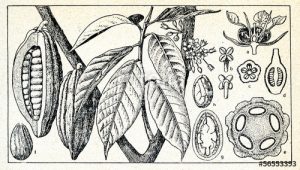by Renate Sander-Regier
With Easter just around the corner, and bunny and egg treats lining the store shelves, it is hard not to think about chocolate.
Chocolate thoughts can go in many directions. On this sunny, late-March morning, mine turn to its origins. I wonder about the cacao (or cocoa) tree, and the cocoa flowers that need pollination to produce cocoa beans. Without those beans, we would have no cocoa powder, no cocoa butter, no chocolate Easter treats… no chocolate – a chilling prospect for chocolate lovers the world over.
But, luckily, we have insects to pollinate cocoa flowers. And cocoa pollination is a fascinating story – starring peculiar trees (Theobroma cacao), curious flowers, and unexpected pollinators. It illustrates the complexity of pollination strategies, the uniqueness of flower-pollinator relationships, and the diversity of pollinators active in the natural world around us.
 The intricacies of cocoa flower pollination are still being studied, and the many details surrounding chocolate and pollination are too complex for one little blog post. But the following particulars stick in my mind:
The intricacies of cocoa flower pollination are still being studied, and the many details surrounding chocolate and pollination are too complex for one little blog post. But the following particulars stick in my mind:
- The flowers of the Theobroma cacao tree grow straight out of the trunk and branches of the tree. What a strange and wondrous sight that must be! (photos on Pinterest)
- The small, pretty flowers are shaped in a way that makes pollination very difficult. The petals curl over the male, pollen-producing structure of the flower, making it accessible only to very small insects. And the flowers apparently offer very little in the way of nectar to attract pollinators.
- The very small insects that pollinate cacao flowers are tiny, annoying biting midges (of the sort we commonly call no-see-ums or sand flies) mainly in the Euprojoannisia or Forcipomyia genera. These insects are unable to fly far, which makes their pollination capacity a bit mysterious. But they are found around the world, which has enabled the spread of the cacao tree far beyond its Central and South American homeland.

The cacao tree and its famous fruits (left, photo: Wikimedia) and the pollinating chocolate midge (right, photo: NPS.gov). See Valentine’s Day: for the love of flies for more.
And that is only a little bit of the fascinating cacao pollination story. The following sources provide a fuller account, with more vivid detail – intriguing Easter holiday reading if you are interested:
- The flowers that give us chocolate are ridiculously hard to pollinate
- The budding relationship of a midge and the chocolate flower
- You wouldn’t have chocolate without invisible flies and extreme yeast
- The unexpected pollinator of the cocoa tree
You may also wish to tune into the website of Emily E. Kearney at the University of California Berkeley. She studies cacao production, natural habitat, and pollination services.
Renate Sander-Regier has a passion for wild bees. She seeks to encourage them and other native pollinators in different habitat planting projects – at her rural home, the Fletcher Wildlife Garden, the University of Ottawa campus, and more.